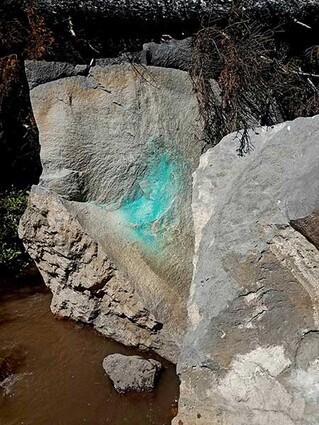Discovering a hidden gem
Last updated 9/16/2020 at Noon

Gary Townsend
A pair of local explorers discovered an interesting geological phenomenon out in the woods.
My friend Gary and I have been exploring the wilderness of our Three Sisters Cascade range for years. The other day we started at a trailhead in an area we are generally familiar with. After a short time following the trail, we spontaneously veered off into the underbrush in a direction that we never explored, letting curiosity be our compass.
This kind of adventuring combines the elements of wonder, surprise, and uncertainty with a hefty dose of hardship and potential danger. (We have about 80 years of combined wilderness experience and do not recommend others follow our lead without proper experience, gear, a GPS and a developed sense for adventure.)
We found ourselves walking several hours up and through rugged overgrown terrain, following deer trails and trusting our innate sense of adventure. We ascended the flow of a rushing creek, climbed over endless fire-fallen trees, waded through thick masses of head-high snowbrush, bouldering ever higher. As we rounded a bend, with the echo of the creek increasingly amplified, we saw an impressive series of cascading waterfalls.
As we got closer, maybe a few hundred yards away, we saw a large slab rock that had come off the side wall of the canyon. It was planted in the middle of the upper falls and was beautifully carved by eons of winter runoff of the rushing creek. But as we neared, the wonder and beauty of the moment disappeared in an instant. It looked as if someone had sprayed bright neon green paint on the rock. Who would have come all the way up here to deface this magnificent rock? We continued our approach with a mix of dismay and angst.
As we got closer, the graffiti became obscured by the terrain, and we lost track of the defaced boulder. The ravine was steep, with many drop-offs, which made getting to creek level too dangerous. But as I looked across the ravine, I could see that there were traces of color on some of the surrounding rocks as well. Excitement clicked in triggering my mineralogical mind, and everything changed. (I have been an artist working with gems and minerals for almost 40 years.)
The color in the formation appeared to be chrysocolla, a close mineralogical relative of turquoise. Chrysocolla is a hydrated copper phyllosilicate mineral, or more simply stated, a strikingly beautiful rock. Over time, traces in the copper mineral had oxidized, turning a beautiful blue-green.
As we climbed closer, we found a safe section of the creek where we could both cool off and cross to the other side. Once across, we paralleled the falls, looking for the colored stone. And there it was… the old masterpiece. Mother Nature had painted a three-foot splash of color directly in the center of the rock slab. A thin, vivid patina layer of chrysocolla. There were little wisps of chrysocolla in the surrounding rock formations.
Apparently, eons ago Mother Nature was testing her color palette and dabbed this lovely blue green mineral on the canvas of gray slab rock.















Reader Comments(0)